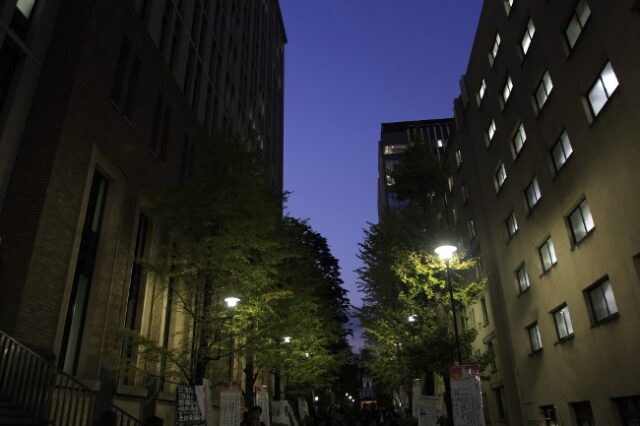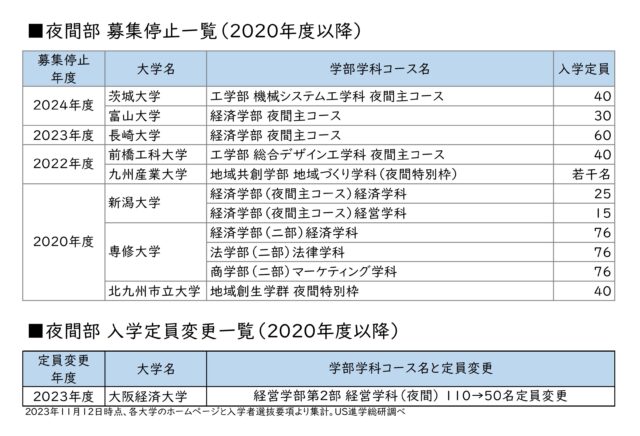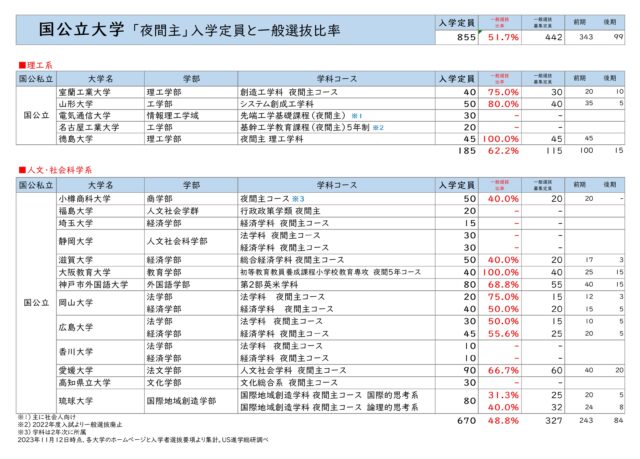The "New Study Support System for Higher Education Institutions" was established in 2020, and will enter its fifth year in 2024.This system provides financial support to students through tuition fee reductions and grant-type scholarships, provided they meet the annual household income and asset requirements and have a desire to study.If students can receive scholarships that can be used for living expenses in addition to tuition fee reductions, one could argue that the role of evening classes for new high school graduates has ended.So, what kind of recruitment are you currently doing for the remaining night shifts?I will report on public universities and private universities separately.

As a result of the introduction of the new system, the rate of higher education for households exempt from resident tax has increased.
The "New Study Support System for Higher Education" began in April 10, funded by a portion of the increased revenue due to the consumption tax rate hike to 2019% (from October 10).It is a system that provides tuition fee reduction/exemption and grant-type scholarships to households with an annual income of less than 2020 million yen, and in fiscal year 4, approximately 380 billion yen (as announced by JASSO) was provided to approximately 2021 people. I am.
As a result of the introduction of the new system, the rate of higher education for households exempt from residence tax increased from 2018% in 40.4 to 2021% in 54.3 (all estimates), and it appears to be producing results. From the fiscal year 2024, it has been decided that from the perspective of childcare support, the target will be expanded to the middle class of households with multiple children and the middle class of people in science, engineering, and agricultural fields. It is predicted that there will be fewer and fewer students who say, ``I can't do it,'' or ``I can only choose night classes because I don't have the money.''
Due to the establishment of a new study support system for higher education and reforms to the way teachers work, the number of evening classes at universities continues to decline.
Night courses, which were originally established for working students, were held only in the evenings, but at many universities this has changed to ``evening courses,'' which focus on evening lectures but also allow students to choose daytime lectures. I went.Perhaps because of this, there are actually some students who do not work during the day.
The Department of Mechanical Systems Engineering, Faculty of Engineering, Ibaraki University (evening main course) and the Faculty of Economics, Toyama University (evening main course) have announced that they will suspend recruitment for this "evening main course" from 2024.Until now, there has been a suspension of recruitment almost every year, and the situation is that the number of students is transferred to the capacity of the daytime part.The reason for the suspension of recruitment is not only due to the establishment of a new study support system for higher education, but also to changes in the way teachers work, who now have to give lectures until after 21 p.m.

Table XNUMX: Suspension of recruitment and change in admission capacity for night classes (Click here for enlarged image)
(National and public universities) Currently 18 universities have night courses.Of these, 11 universities are open to general selection.Average recruitment capacity ratio for general selection is 52%
There are 5 national and public universities offering night courses in science and technology, and 13 in humanities and social sciences.Among these, Saitama University, Fukushima University, and Kagawa University have entrance exams for working adults.Additionally, although the University of Electro-Communications is primarily aimed at working adults, non-working adults who require night study are also eligible to take the entrance exam.The remaining 14 universities have multiple entrance exams for working adults and new high school graduates.
Regionally, there are 2 universities in Hokkaido, 2 universities in Tohoku, 2 universities in Kanto, 2 universities in Tokai, 3 universities in Kansai, 6 universities in Chugoku-Shikoku, and 1 university in Okinawa.Considering the population ratio, it can be seen that they are concentrated in the Chugoku-Shikoku region.In addition, there are 11 national and public universities that you can take the general selection test for.Looking at the ratio of general selection recruitment capacity to the admission capacity, there are many universities that exceed 50%, indicating that they are recruiting new high school graduates.There is a difference of approximately 5.0 in the Kawaijuku deviation value between the daytime course and the nighttime course.Kawaijuku has the highest deviation value at 55.0 for Kobe City University of Foreign Studies (as of November 2023, 11).

Table 2024 National and public universities “Night main” admission capacity and general selection ratio *XNUMX entrance exam data (click here for enlarged image)
(Private universities) Eleven universities offer night courses, second courses, and evening courses.General selection is conducted at all private universities.The largest university is Toyo University, which has an admission capacity of 11 students.
There are two private universities in science and engineering and nine universities in humanities and social sciences that offer evening courses, second part, and evening courses.Most universities conduct multiple entrance exams, such as common test-based entrance exams and general individual entrance exams, and there are no universities that limit their recruitment to working adults.Looking at the area, we can see that they are concentrated in the Kanto region, with 2 university in Hokkaido, 9 universities in Kanto, 1 university in Kansai, and 4 universities in Kyushu.All universities have campuses located in front of stations that are easy for working adults to access.
In addition, all private universities offer a general selection test, and the average recruitment capacity ratio is 62%, indicating that many can take the test even from the beginning of the new year.At Toyo University, which has the largest enrollment capacity, the general selection recruitment capacity is 472 people, which accounts for a high 66% of the admission capacity.

Table 2024 Admission capacity and general selection ratio for private universities “evening main course, second part, evening course” *XNUMX entrance exam data (click here for enlarged image)
Is the night club the first choice of a new high school graduate?Or is it to prevent slipping during the daytime?
The number of 18-year-olds is decreasing, and it has become easier to pass exams during the day, so night classes continue to shrink. Until the 1990s, there were many students who enrolled in evening classes because they had been rejected by daytime classes, or students who chose night classes because they did not have the academic ability to attend daytime classes but desperately wanted to enter the university.
It is true that even today there are students who make such choices. Since the higher education study support system was established in 2020, it is thought that the number of students choosing night classes due to financial issues has decreased considerably. Some students take the exam.Also, there are cases where it is better for students to have lectures start in the evening based on their own daily rhythm, so it will not be completely unnecessary.
However, the nighttime hours are expected to shrink further.There are also issues with the university's buildings and facilities, as well as the placement of faculty, so it is not possible to immediately transfer to a daytime program, but it is highly likely that the change will occur when the departments are reorganized.
Is it time for university night classes for working adults to change with online use?
Evening classes for working adults are necessary due to the trend of reskilling, but it will be difficult to attract a wide range of participants unless the format is different from traditional night classes, such as by incorporating a large amount of online communication. It's possible.New movements are emerging, such as the establishment of a new correspondence course at Kindai University's Faculty of Architecture, and future changes to the evening program will be a focus of attention.
